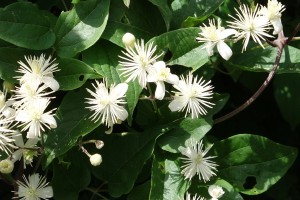Old man's beard leaf miner
History in New Zealand
Old man's beard leaf miners are native to Europe, and they were first imported from Switzerland by Landcare Research in 1994. The flies were mass-reared and released throughout New Zealand in the summer of 1996/97. Old man's beard leaf miners soon established but are attacked by native and exotic parasitoids and so are now less common at sites in both the North and South Islands.
How would I find/recognise it and what is its lifecycle?
You are unlikely to see the tiny (1-2 mm long) adult flies or, if you do, to be able to distinguish them from other fly species.

Image: old man's beard leaf miner (Phytomyza vitalbae) adult fly.
The adults lay eggs inside the leaves and are too small to see. The eggs hatch after about a week into small white maggots. The maggots tunnel between the top and bottom layer of the leaves leaving a squiggly mine behind them. The best way to find old man's beard leaf miner is to look for these larval mines. If you hold a mined leaf up to the light you may be able to see the larva feeding at the head of the mine. You may also see tiny pinpricks in the leaves that the females make with their ovipositors. Eggs are occasionally laid inside these punctures, but the flies more commonly use them to feed on the leaf exudate.
Image: leaf mines made by old man's beard leaf miner larvae.
The larvae feed for about 11 days, and then they emerge to form a brown cocoon on the leaves, stems, or soil. The cocoons turn black as they mature, and new adults emerge after nearly a fortnight.

Image: old man's beard leaf miner pupae.
The warmer the temperature, the faster the flies develop. At 25°C one generation from egg to adult can take as little as 3 weeks. In its native Switzerland the old man's beard leaf miner has five generations a year, and we believe that it may be capable of more here in New Zealand.
Over the winter (when the plant has no leaves) the leaf miners remain as pupae. Once the temperature rises in the spring and the plant begins to grow leaves, the new adults emerge. You may see leaf mines as early as October, but you will find them most easily in the autumn when the leaf miner population has built to higher numbers. Although leaf mines from larval feeding can still be found they are less common and have little impact on the plant.
How does it damage old man’s beard?
The old man's beard leaf miner damages the plant in several ways. The larvae disrupt the flow of nutrients around the leaves by mining through the veins. Heavily scarred leaves turn brown, shrivel up, and fall off the plant. Both the larval mines and the adults' feeding punctures also allow fungal pathogens (see Old man's beard fungus) to invade the plant, and the adult flies can act as vectors.

Image: old man's beard leaf miner larvae damage.

Image: old man's beard leaf miner larvae damage (narrow squiggly line) and fungal infection (large dark area).
Will it attack other plants?
The old man's beard leaf miner may cause slight damage to some of the ornamental Clematis species that are closely related to old man's beard. The old man's beard leaf miner has occasionally been recorded attacking native Clematis plants (mainly Clematis foetida, but also C. forsteri on one occasion). Because the females need to feed on old man's beard before they can lay eggs, this non-target attack tends to occur on plants growing in close proximity to old man's beard. This non-target attack was predicted by host- range testing and can easily be confused with mining done by a native leaf miner (Phytomyza clematidi) which also occasionally attacks old man's beard.
See Insects commonly mistaken for biocontrol agents.
How effective is it?
The effectiveness of the old man's beard leaf miner in New Zealand is limited and not significant because of the impacts of the parasitoids preventing fly populations building into damaging levels. A lab study showed that 2-3 mines per leaf can reduce the growth of small plants by 50%. While some damaging outbreaks have been seen anecdotal evidence suggests that the number of mines per leaf has remained low so the leaf miner is not having enough impact overall or early enough in the season to be useful. The reason for this is parasitism by six native and 2 exotic parasitoids present here.
How can I get the most out of it?
The leaf miner is already widespread and given that it is likely to be limited by parasitism there is nothing you should do to try to augment them.
Key contact




